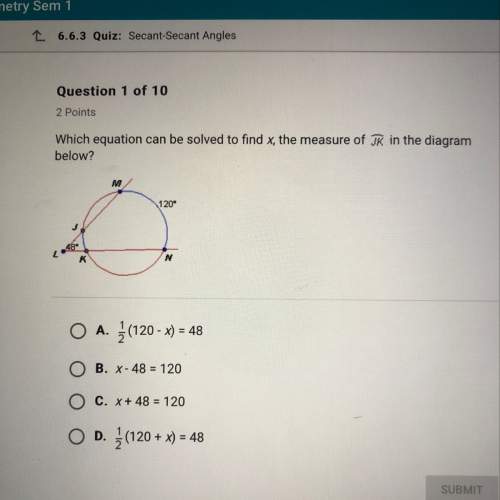
Mathematics, 11.03.2021 04:00 Anonymous7170
Please answer.. i'm bouta cry. I dont get this.
The vertices of ΔABC are A (1, 5), B (3, 9), and C (5, 3). The vertices of ΔDEF are D (−3, 3), E (−2, 5), and F (−1, 2). Which conclusion is true about the triangles?
The ratio of their corresponding sides is 1:3.
They are congruent by the definition of congruence in terms of rigid motions.
The ratio of their corresponding angles is 1:3.
They are similar by the definition of similarity in terms of a dilation.

Answers: 1


Another question on Mathematics

Mathematics, 21.06.2019 17:20
Which of these equations, when solved, gives a different value of x than the other three? a9.1 = -0.2x + 10 b10 = 9.1 + 0.2x c10 – 0.2x = 9.1 d9.1 – 10 = 0.2x
Answers: 1

Mathematics, 21.06.2019 21:30
Acompany charges $0.10 for each letter engraved. bobby plans to spend no more than $5.00 on the engraving on a jewelry box. write and solve an inequality to find the maximum number of letters he can have engraved.
Answers: 1

Mathematics, 21.06.2019 22:30
What is the distance from zero if a quadratic function has a line of symmetry at x=-3 and a zero at 4
Answers: 1

Mathematics, 22.06.2019 01:00
Why is causation so much more difficult to prove than correlation?
Answers: 2
You know the right answer?
Please answer.. i'm bouta cry. I dont get this.
The vertices of ΔABC are A (1, 5), B (3, 9), and C...
Questions


Social Studies, 26.03.2020 03:26

Mathematics, 26.03.2020 03:26


History, 26.03.2020 03:26

Computers and Technology, 26.03.2020 03:26



Mathematics, 26.03.2020 03:27






Mathematics, 26.03.2020 03:27



Chemistry, 26.03.2020 03:27

Mathematics, 26.03.2020 03:27






